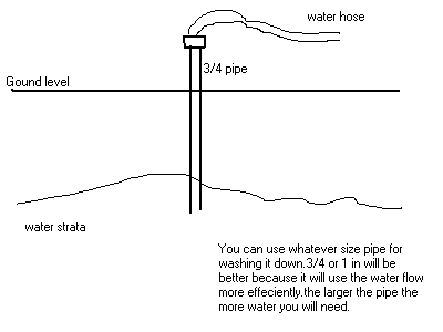
*Putting down a water well yourself*
By: WAB
Here in the South the water table is close to the top of the ground. You usually can find water within 25 ft of the top of the ground. These two methods have been used here with success. Naturally the water is “surface water”. Sometimes it is not fit to drink but is ok for irrigation and such. Standard practice is normally to drill down through the rock layer and keep drilling to the next strata of water. The rock layer separates the surface water from the “drinking” type water. If you use these methods it would be wise to have the water tested before drinking.
The two ways that I am telling you about is the easiest to do by hand.
The first way is to “wash” the pipe down. Take a length of pipe, connect a water hose to it. Make sure you have a good water flow and pressure. Select where you want to put the well. Then turn the water on till you have a good strong flow of water coming out of the end of the pipe. Stand the pipe with the water hose end up in the air, rest the other end on the ground. The weight of the pipe and the water flowing thru it will let the pipe “wash “down. You may have to add more pipe to get down to the layer of water. While you are “washing down”, the water will be coming out from around the outside of the pipe and the ground. When you hit the water layer the water will stop coming out and the pipe will go down faster. Try to get the pipe to another foot or two. Then take the water hose off and then put a pump on the top of the pipe. If you have hit water you should be able to prime the pump and get water flowing very soon. You should pump the water hard and fast to get the sand and trash out of the way by creating a “basin” around the end of the pipe. Try to pump the water till it runs clear. Sometimes it will look “milky” looking but that will go away in a few days. You can use a power pump, electric or gasoline, or a hand pump. While putting down the well and pumping it off, take my advice and rent an electric or gasoline pump. That will take a lot of work out of the job.
If you are going to use a hand pump, my suggestion is to use 1 ¼ in. galvanized pipe because the fitting on the pump is for 1 1/4in pipe. You could use PVC pipe but you wont be able to hit on it if you need to. After you get the well down then you will need to place the pump. You might need to cut the pipe off and use a pipe threader to get the pipe to the proper height. I have included a little diagram below to help explain this method.

The 2nd method is to drive the pipe down. With this method you will need a strong back! And maybe a weak mind as well!! LOL! Using this method you will have to know that water is present and close to the top of the ground. Build a scaffold or have something to use as an elevated work surface. Make real sure it is sturdy!
Get galvanized steel pipe in 8-10 ft lengths. A “well point” is needed too. It is made of steel and brass with screen wire over the holes to keep out trash and sand. Get a sort piece of pipe with a cap to drive it with.You wouldn’t want to drive the pipe down by hitting it with a sledge hammer, it will damage it. The short pipe and cap can be unscrewed and trown away after the job is over. This will prevent damage to the pipe.
Put the well point and short drive pipe onto one section of pipe. Have a friend to hold it upright while you drive it into the ground with a sledge hammer. Drive it down to the depth you think water is then unscrew the drive pipe, put the pump on and see if you can pump water. If not, drive it a couple of feet and try again.Keep on till you either pump water or can’t drive the pipe anymore.
Needless to say, this method is the more labor intensive one. You may drive pipe and come up empty.You will certainly NOT get the pipe out of the ground once you drive it down.
After you hit water you will need to pump it off the same way as above.
I hope these methods will help someone when they need it the most.
WAB
All materials at this site not otherwise credited are Copyright © 1996 - 2001 Trip Williams. All rights reserved. May be reproduced for personal use only. Use of any material contained herein is subject to stated terms or written permission.